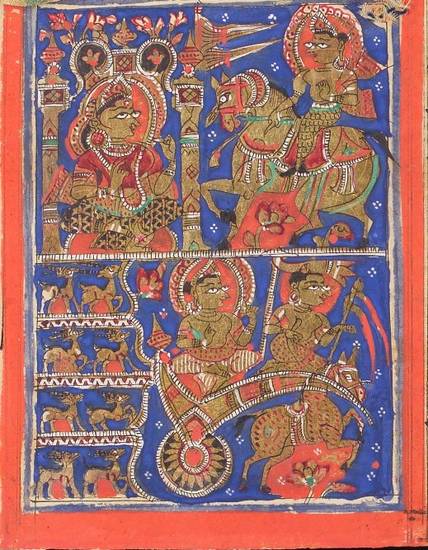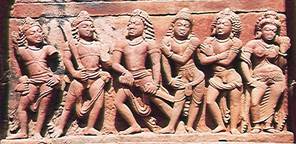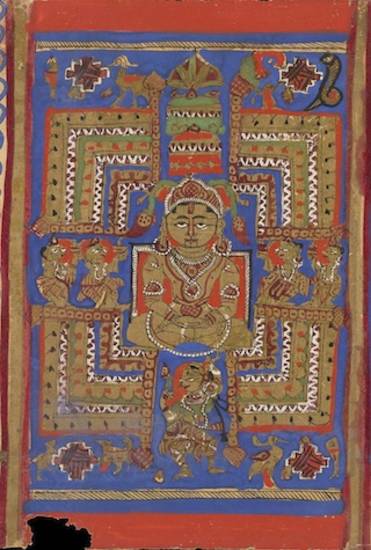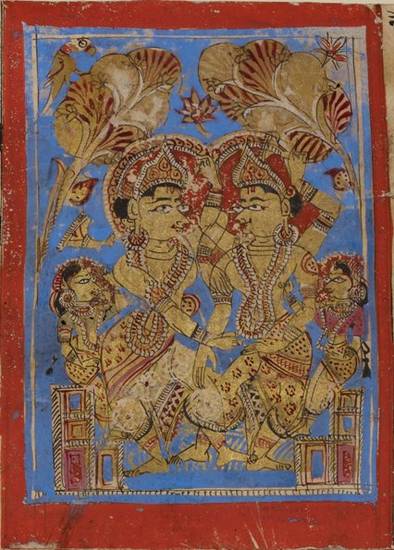Article: Jain Mahābhāratas
The legends, stories and characters of the Mahābhārata, the Sanskrit epic attributed to the seer Vyāsa, became so popular throughout and beyond South Asia that Jains developed their own accounts. Jain poets composed distinctly Jain versions, situating the events of the Mahābhārata within Jain Universal History.
However, what are considered the Jain Mahābhāratas are not limited to the story of the Pāṇḍavas and the Kauravas, who are the main figures in the Hindu Mahābhārata. Jain versions of the Mahābhāratas also include:
- the biography of Kṛṣṇa, whom the Jains consider to be the ninth Vāsudeva of the current era
- the biography of the 22nd Jina Neminātha or Lord Nemi
- a version of another popular South Asian narrative cycle, known as the Bṛhatkathā.
In these ways, the Jain Mahābhāratas reinforce Jain beliefs and strengthen a sense of particularly Jain culture, though elements are shared with wider Indian society.
Jain Universal History
Though now a key part of the Hindu canon, the early forms of the Mahābhārata did not especially promote Hindu values or beliefs. One of the principal differences between the Jain and Hindu versions of the tale is the classification of certain characters and the perspective this gives the stories. This is one of the main features that make the Jain Mahābhāratas distinctly Jain even though there are many versions. These characters form part of Jain Universal History, a large body of texts that contains much of the mythology of Jain culture. The characters and narrative are also expanded in the Jain versions.
Jains consider some of the characters of the Mahābhārata and the Rāmāyaṇa to be mahā-puruṣas or śalākā-puruṣas – ‘great men’. In the Jain telling of the Rāmāyaṇa the protagonists are the mahā-puruṣas. However, the heroes in the Jain Mahābhārata, the Pāṇḍavas, are not classed as Jain great men. None of the Pāṇḍavas or Kauravas – their great enemies – is considered to be a great man.
Instead, the focus in the Jain Mahābhāratas is more on Kṛṣṇa, his brother Balarāma and their enemy Jarāsaṃdha. These characters are secondary to the main narrative of Vyāsa’s Hindu Mahābhārata.
- Kṛṣṇa is the ninth Vāsudeva
- his half-brother Balarāma or Baladeva is the ninth Baladeva
- their enemy Jarāsaṃdha is the ninth Prati-vāsudeva.
These three types of great men are fated to fight each other in each half-cycle of time. The Prati-vāsudeva battles his mortal enemy the Vāsudeva, who is supported by his half-brother, the Baladeva.
Four topics

Kṛṣṇa and the Pāṇḍavas
Image by Gift of Doris and Ed Wiener, Brooklyn Museum © No known copyright restrictions
The primary characters and narrative are expanded in the Jain Mahābhārata. In the Jain Mahābhāratas these four distinct topics have generally become intertwined:
- the life story of Kṛṣṇa
- the life of Neminātha or Lord Nemi
- the story of the Pāṇḍavas and the Kauravas
- the narrative cycle of the Bṛhat-kathā.
There is a shift in focus from the Pāṇḍavas to Kṛṣṇa in the Jain Mahābhāratas which is most likely due to the rise and development of Kṛṣṇa as a Hindu divinity. This development made Kṛṣṇa a more important character in Hinduism and thus in the Mahābhārata story too. This general tendency affected the Jain Mahābhārata.
The figure of Kṛṣṇa is first introduced in the Hindu Mahābhārata, which started life around 400 BCE. The events of the Jain Mahābhārata take place at the time of the 22nd Jina, Nemi. Since he is a cousin of Kṛṣṇa, Nemi’s story is also generally included in the Jain Mahābhāratas.
Kṛṣṇa’s biography
Prince Kṛṣṇa, born to Devakī and Prince Vasudeva in Mathurā, is prophesied to cause the death of his uncle, Kaṃsa. Therefore, immediately after his birth, Vasudeva and Kṛṣṇa’s elder half-brother Baladeva take him to a colony of herdsmen. There he grows up safely hidden from his uncle, who is intent on killing him.
After many years and adventures, he returns to Mathurā, kills Kaṃsa in a wrestling match and is reunited with his parents. Though the prophecy is fulfilled, there is no emphasis on this in the tale. This course of events is the same as in the Hindu version of Kṛṣṇa’s biography.
Soon thereafter Mathurā comes under attack from a neighbouring king, Jarāsaṃdha. Kṛṣṇa and his subjects flee to the west, towards the ocean, where they live in the new city of Dvāravatī, constructed by the gods. There Kṛṣṇa marries several queens and has many sons.
In due time, King Jarāsaṃdha wages war on Kṛṣṇa again. Six months later, the two monarchs agree to meet for a decisive battle, both gathering a vast number of allies. Kṛṣṇa kills Jarāsaṃdha in a duel.
Eventually, Dvāravatī is burned by a vengeful god, and only Kṛṣṇa and Baladeva escape. On their way south, Kṛṣṇa is killed by a hunter who mistakes him for a deer.
Nemi’s biography

Nemi’s renunciation
Image by Wellcome Trust Library © Wellcome Library, London
The boy who will become the 22nd Jina, Nemi or Ariṣṭanemi, is the son of Samudravijaya and younger cousin to Kṛṣṇa. Nemi grows up to become a man of unequalled power. Noticing this, Kṛṣṇa becomes worried for his own sovereignty. He arranges for Nemi to marry.
Just before the wedding, the young prince wanders around the park and is struck by the wailing animals which have been lined up to be slaughtered for his wedding banquet. Filled with disgust, he renounces the world.
The monk Nemi achieves omniscience and becomes a Jina. He roams the land preaching to his followers, including Kṛṣṇa and his other relatives, until he achieves final emancipation on Mount Girnar.
Story of the Pāṇḍavas

Pāṇḍava brothers and Draupadī
Image by Vaticanus – Bob King © CC BY 2.0
One day in Dvāravatī, Kṛṣṇa receives a visit from five men, the Pāṇḍavas or sons of Pāṇḍu. Their rivalry with their 100 cousins, the Kauravas, has led to several attacks on their lives and years in exile.
The tale of the Pāṇḍavas’ adventures commences. When the eldest of the Pāṇḍavas is seduced into gambling away all their possessions in a game of dice, the five brothers spend years in exile in the forest. They then spend one year incognito at the court of King Virāṭa. They are accompanied throughout their exile by Draupadī, who, according to the Jains, is the wife of one Pāṇḍava brother, Arjuna. In Vyāsa’s Mahābhārata, Draupadī is considered the wife of all five brothers. After this period of exile, they all return to their ancestral city but again have to flee to avoid war.
When they arrive at Kṛṣṇa’s court in Dvāravatī, the brothers form an alliance with him and assist him in the fight against Jarāsaṃdha.
According to the Jains, the great clash between Pāṇḍavas and Kauravas that is the centrepiece of the Hindu Mahābhārata is in fact the battle between Kṛṣṇa and Jarāsaṃdha. These latter are the ninth Vāsudeva and Prati-vāsudeva, and the Pāṇḍavas are among Kṛṣṇa’s many allies, whereas the Kauravas fight on the side of Jarāsaṃdha. Ultimately, Kṛṣṇa and the Pāṇḍavas are victorious over Jarāsaṃdha and the Kauravas.
Narrative cycle of the Bṛhat-kathā
Aside from the epics and other religious stories, other more or less secular narrative cycles developed in India. One example is known as the Bṛhat-kathā – Great Story – first attributed to Guṇāḍhya. The original Bṛhat-kathā being lost, this narrative cycle survives in many later retellings, including some composed by Jains.
The Bṛhat-kathā centres on the adventures of a prince, Naravāhanadatta, who gains 26 wives. The Jains include this narrative cycle in their Mahābhārata. They ascribe Naravāhanadatta’s amorous adventures to Vasudeva, Kṛṣṇa’s father, before the birth of his sons. This part of the Jain Mahābhāratas is generally referred to as Vasudeva-hiṇḍi – Wanderings of Vasudeva.
Literary forms

Mahāvīra preaching to his universal gathering
Image by Wellcome Trust Library © Wellcome Library, London
As part of Jain Universal History, the Jain Mahābhārata is typically told in a Jain Purāṇa, introduced by a narrative setting of Mahāvīra’s samavasaraṇa attended by King Śreṇika. Some episodes from the Jain Mahābhārata are present in the Śvetāmbara canonical texts, suggesting an early date for their assimilation into Universal History.
The first complete Jain Mahābhārata is the Harivaṃśa-purāṇa – Purāṇa of the Dynasty of Hari – which Jinasena Punnāṭa finished in 783. Its title clearly echoes the appendix of the Mahābhārata with the same name. In the Jain context it refers to the dynasty to which the main characters belong, the cousins:
A second title under which the Jain Mahābhāratas also often come is Biography of Nemi. An example is the Riṭṭhaṇemi-cariu by Svayambhū-deva, composed in the 9th to 10th century. Even though this title may give the impression of focusing on the life of Nemi, this is not the case. In fact, this Apabhraṃśa epic is the first Jain Mahābhārata proper. This is because the great majority of the composition deals with the story of the Pāṇḍavas and the Kauravas, and the great battle between them, dwarfing the other three topics. The choice of the name Biography of Nemi for this and other compositions is considered to be due to the relative higher status of Nemi, as a Jina, compared with Kṛṣṇa or the Pāṇḍavas. It does not indicate a particular emphasis in the composition.
From the 13th century onwards, a third title came to be used for the same narrative material. This is the Pāṇḍava-purāṇa or Pāṇḍava-carita. These versions tend to focus on the conflict between the Pāṇḍavas and the Kauravas, but still include the other three topics.
|
Title |
Author |
Detail |
|---|---|---|
|
Harivaṃśa-purāṇa |
Jinasena Punnāṭa |
783 |
|
Riṭṭhaṇemi-cariu – Biography of Nemi |
Svayambhū-deva |
written in Apabhraṃśa, in the 9th to 10th century |
|
Pāṇḍava-carita – Acts of the Pāṇḍavas |
Devaprabha-sūri |
1214 |
|
Pāṇḍava-purāṇa – Purāṇa of the Pāṇḍavas |
Śubhacandra |
1552 |
The 5th-century Vasudeva-hiṇḍi by Saṅghadāsa appears to be unique in its concentration on the Bṛhat-kathā material. It reduces the other three topics to subsidiary episodes to the main narrative of Vasudeva and his adventures.
Reading
- ‘An Overview of the Jaina Purāṇas’
John E. Cort - Purāṇa Perennis: Reciprocity and Transformation in Hindu and Jaina Texts
edited by Wendy Doniger
State University of New York Press; New York, USA; 1993
- ‘The Jaina Harivaṃśa and Mahābhārata tradition: A preliminary study’
Eva De Clercq - Parallels and Comparisons in the Sanskrit Epics and Purāṇas
edited by Petteri Koskikallio
Proceedings of Dubrovnik International Conference on the Sanskrit Epics and Puranas series; series editor Mislav Ježić; volume 4
Croatian Academy of Sciences and Arts; Zagreb, Croatia; 2009
- ‘A Purāṇic Counter Tradition’
Padmanabh S. Jaini - Purāṇa Perennis: Reciprocity and Transformation in Hindu and Jaina Texts
edited by Wendy Doniger
State University of New York Press; New York, USA; 1993
Links
- Mahābhārata – English translation
-
The Internet Archive offers Romesh Dutt's 1898 translation of the Sanskrit epic poem Mahābhārata into English verse. One of the Hindu accounts of the poem, it can be read online or downloaded in various formats.
- Mahābhārata – English translation
-
The Internet Archive offers Romesh Dutt's 1898 translation of the Sanskrit epic poem Mahābhārata into English verse. One of the Hindu accounts of the poem, it can be read online or downloaded in various formats.
- Mahābhārata – English translation
-
The Internet Archive offers Romesh Dutt's 1898 translation of the Sanskrit epic poem Mahābhārata into English verse. One of the Hindu accounts of the poem, it can be read online or downloaded in various formats.
- English translations of the Sanskrit epics
-
Romesh C. Dutt's abridged English translations of the ancient Sanskrit epics, the Mahābhārata and the Rāmāyaṇas. Initially published in 1899, the poems are in rhyming couplets and are Hindu tellings of the works. Provided by the Sacred Texts website, the text can be read online or downloaded as a plain text file.
- +
- aAbhavya
- aAbhinandana
- aAbhiṣeka
- aĀcāra
- aĀcārāṅga-sūtra
- aĀcārya
- aAchalbhrata
- aAḍhāī-dvīpa
- aAdharma
- aAdho-loka
- aAdhyayana
- aAdvaita Vedānta
- aĀgama
- aAghātīya
- aAghātīya-karman
- aAgnibhuti
- aAgra
- aĀhāra
- aAhiṃsā
- aAhimsa Day
- aAjita
- aAjīva
- aAkampit
- aĀkāśa
- aAkbar the Great
- aAkṣaya-tṛtīyā
- aAlauddin Khalji
- aAlbert Einstein
- aAllah
- aAlms
- aĀlocanā
- aAloka-ākāśa
- aAmāri
- aAmbikā or Kūṣmāṇḍinī
- aAnagāra
- aAnanta
- aAnarthadaṇḍa
- aAnaśana
- aAnekānta-vāda
- aAṅga
- aAniconism
- aAnojjā
- aAntarāla
- aAntarāya-karma
- aAṇu
- aAṇu-vrata
- aAnukampā
- aAnuprekṣā
- aAnusvāra
- aApabhraṃśa
- aAparigraha
- aAra
- aĀrambha
- aĀrambhaja
- aĀratī
- aArdhamāgadhī Prākrit
- aArhaṃ
- aArhat
- aArśana-āvaraṇīya-karma
- aĀrta-dhyāna
- aĀryikā
- aĀryikā Jñānamati
- aĀśātanā
- aĀścarya
- aAscetic
- aAsceticism
- aAshram
- aAspiration
- aĀsrava
- aAṣṭa-maṅgala
- aAṣṭāpada
- aAstikāya
- aAstrolabe
- aAsura
- aAtheism
- aAticāra
- aAtiśayakṣetra
- aAtithisaṃvibhāgavrata
- aĀtma-vāda
- aĀtman
- aAuṃ
- aAurangzeb
- aAuspicious
- aAusterity
- aAvadhāna
- aAvadhi-jñāna
- aĀvaraṇī-yakarman
- aAvasarpiṇī
- aAvatāra
- aAvidyā
- aAxiom
- aĀyāga-paṭa
- aĀyambil
- aĀyu-karma
- aĀyurveda
- bBabur
- bBāhubali
- bBaladeva
- bBālāvabodha
- bBandha
- bBasadi
- bBazaar
- bBhadrankarvijay
- bBhagavant
- bBhaktāmara-stotra
- bBhakti
- bBhale
- bBharata
- bBhāṣā
- bBhāṣya
- bBhaṭṭāraka
- bBhāva
- bBhāva-pūjā
- bBhāvanā
- bBhavana-vāsin
- bBhavya
- bBhavyatva
- bBhaya
- bBhoga-bhūmi
- bBhogopabhoga
- bBodhi
- bBollywood
- bBrahmā
- bBrahma-deva
- bBrahmacārī
- bBrāhmaṇa
- bBraj Bhāṣā
- bBright fortnight
- bBritish Raj
- bBuddha
- bBuddhi-sagar
- bBuddhism
- bBuddhist
- cCaitya
- cCaityavāsin
- cCakravartin
- cCakreśvarī
- cCāmara
- cCandanā
- cCandragupta
- cCandraprabha
- cCanon
- cCāritra
- cCāritramohanīya-karman
- cCarũrī
- cCaste
- cCaturvidha-saṅgha
- cCaturviṃśati-stava
- cCāturyāma
- cCE
- cCelibacy
- cCha
- cChadmastha
- cChastity
- cCheda-sūtra
- cChristian
- cChristianity
- cClergy
- cCloning
- cColophon
- cCommentary
- cConch
- cConfession
- cCongregation
- cConsecration
- cCosmology
- cCremation
- cCrore
- cCult
- cCūrṇi
- dDādā-guru
- dDalit
- dDāna
- dDaṇḍa
- dDark fortnight
- dDarśana
- dDarśanamohanī-yakarman
- dDaśa-lakṣaṇa-parvan
- dDeity
- dDelhi Sultanate
- dDerāsar
- dDeśāvakāśika-vrata
- dDetachment
- dDevanāgarī
- dDevānandā
- dDevarddhi-gani
- dDevotee
- dDhamal
- dDhanuṣ
- dDhāra
- dDharma
- dDharma-dhyāna
- dDharma-sāgara
- dDharmastikaya
- dDhātakīkhaṇḍa
- dDholak
- dDhyāna
- dDiaspora
- dDig-vrata
- dDigambara
- dDīkṣā
- dDisciple
- dDīvālī
- dDivya-dhvani
- dDNA
- dDoctrine
- dDogma
- dDonor
- dDoṣa
- dDravya
- dDravya-pūjā
- dDrone
- dDuṣamā
- dDuṣamā-duṣamā
- dDuṣamā-suṣamā
- dDveṣa
- dDvīpa
- eEast India Company
- eEightfold Path
- eEkānta-vāda
- eEkendriya
- eElder
- eElders
- eEschatology
- eEtc up to
- fFarmān
- fFast
- fFatehpur Sikri
- fFestival
- fFestschrift
- fFiruz Shah
- fFly-Whisks
- fFolio
- fFour Noble Truths
- gGaccha
- gGaṇa
- gGaṇadhara
- gGanadharavada
- gGaṇeśa
- gGaṇin
- gGarba
- gGarbha
- gGarbha-gṛha
- gGaruḍa
- gGati
- gGene
- gGenomics
- gGhātī-yakarman
- gGhātīya
- gGhaznavid
- gGhiyasuddin Tughlaq
- gGhurid
- gGloss
- gGotra-karma
- gGujarāt
- gGujarati
- gGuṇa
- gGuṇa-sthāna
- gGuṇa-vrata
- gGupti
- gGuru
- gGuruṇī
- hHagiography
- hHajj
- hHaṃsa
- hHaribhadra
- hHariṇaigameṣin
- hHasta
- hHeresy
- hHiṃsā
- hHindi
- hHindu
- hHinduism
- hHīravijaya
- hHoroscope
- hHrīṃ
- hHumayun
- hHymn
- iIconoclasm
- iIconography
- iIdol
- iIndian Independence
- iIndology
- iIndra
- iIndrabhūti Gautama
- iIndriya
- iInitiation
- iIntercession
- iInvocation
- iIQ
- iIslam
- iIslamicate
- iIṣṭadevatā
- iĪśvara
- jJagat
- jJahangir
- jJain
- jJaina Devanāgarī
- jJaina Śaurasenī
- jJaina-dharma
- jJainaśāsana
- jJainness
- jJaisalmer
- jJamāli
- jJambū-dvīpa
- jJames Burgess
- jJanma
- jJanma-kalyāṇa
- jJarā
- jJāti
- jJina
- jJina-āgama
- jJina-bhavana
- jJina-bimba
- jJina-mātā
- jJinacandra-sūri
- jJinadatta
- jJinaprabha
- jJīva
- jJñāna
- jJñāna-āvaraṇīya-karma
- jJñāna-āvarṇiya
- jJñānsundar
- jJyotiṣka
- kKāla
- kKālakācārya-kathā
- kKālidāsa
- kKalpa-sūtra
- kKalpa-vṛkṣa
- kKalyāṇaka
- kKalyanvijay
- kKamaṇḍalu
- kKamaṭha
- kKarma
- kKarma-bhūmi
- kKarma-grantha
- kKarma-prakṛti
- kKarma-vāda
- kKarmon
- kKarnataka
- kKaṣāya
- kKathā
- kKāvya
- kKāya
- kKāyotsarga
- kKeśa-loca
- kKetu
- kKevala-jñāna
- kKevalin
- kKhalji
- kKharatara-gaccha
- kKnowledge
- kKriyā
- kKriyā-vāda
- kKṛṣṇa
- kKṣamā-śramaṇa
- kKṣapakaśreṇi
- kKṣatriya
- kKṣullaka
- kKulakara
- kKundakunda
- kKunthu
- lLabdhi
- lLaity
- lLakh
- lLāñchana
- lLands of Action
- lLaukāntika
- lLavaṇa-samudra
- lLeśyā
- lLiṅga
- lLinguistics
- lLoka
- lLoka-ākāśa
- lLoka-puruṣa
- lLoka-vāda
- lLotus
- lLotus lake
- mMadhya-loka
- mMahā-videha
- mMahā-vrata
- mMahābhārata
- mMahāmastakābhiṣeka
- mMāhārāṣṭra
- mMāhārāṣṭrī Prākrit
- mMahattarā Yākinī
- mMahāvīr Jayantī
- mMahāvīra
- mMakāra
- mMakkhali Gośāla
- mMalli
- mMāna-stambha
- mManaḥ-paryāya-jñāna
- mMaṇḍala
- mMaṇḍapa
- mMandit
- mMaṅgala
- mMantra
- mMantras
- mManuṣya-loka
- mMarāṭhī
- mMārgaṇā
- mMartyr
- mMarudevī
- mMaṭha
- mMati-jñāna
- mMauryaputra
- mMecca
- mMendicant lineage
- mMetarya
- mMiracle
- mMithyādṛṣṭi
- mMohandas Gandhi
- mMohanīya-karma
- mMokṣa
- mMonastic order
- mMonasticism
- mMonk
- mMonotheism
- mMosque
- mMount Meru
- mMount Sammeta
- mMṛgāvatī
- mMughal
- mMuhammad
- mMuhammad bin Tughlaq
- mMuhpattī
- mMūla-sūtra
- mMūlaguṇa
- mMumbaī
- mMuni
- mMunisuvrata
- mMurad Bakhsh
- mMūrti-pūjaka
- mMuslim
- mMysticism
- nNābhi
- nNāga-kal
- nNāgapurīya Tapā-gaccha
- nNāgarī
- nNāma-karma
- nNamaskāra-mantra
- nNami
- nNandīśvara-dvīpa
- nNandivardhana
- nNandyāvarta
- nNāraka
- nNāraki
- nNasalisation
- nNātha
- nNavrātrī
- nNaya-vāda
- nNemi
- nNidāna
- nniggaṃthāṇa vā 2
- nniggaṃtho vā 2
- nNigoda
- nNihnava
- nNikṣepa
- nNirgrantha
- nNirjarā
- nNirvāṇa
- nNiryukti
- nNiṣidhi
- nNitya
- nNiyati
- nNo-kaṣāya
- nNudity
- nNun
- oOcean of milk
- oOmniscience
- oOrdination
- ppa°
- pPadmaprabha
- pPadmāsana
- pPadmāvatī
- pPādukā
- pPalanquin
- pPalette
- pPañca-muṣṭi
- pPāṇḍava
- pPaṇḍit
- pPandit Dalsukh D. Malvania
- pPandit Sukhlalji
- pPāṇipātra
- pPāpa
- pParamātman
- pParameṣṭhin
- pPāraṇā
- pParigraha
- pPariṇāma
- pParīṣaha
- pParokṣa
- pPārśva
- pPārśvanātha
- pParyāya
- pParyuṣaṇ
- pPaṭa
- pPatan
- pPātra
- pPenance
- pPersian
- pPhala
- pPhilology
- pPicchikā
- pPilgrimage
- pPīr
- pPolymath
- pPoṣadha
- pPossession
- pPothī
- pPrabhas
- pPradakṣiṇā
- pPradeśa
- pPrākāra
- pPrakīrṇaka-sūtra
- pPrākrit
- pPramāda
- pPramukhā
- pPrati-vāsudeva
- pPratikramaṇa
- pPratimā
- pPratiṣṭhā
- pPratyākhyāna
- pPratyakṣa
- pPravacana
- pPrāyaścitta
- pPrayer
- pPre-modern
- pPreach
- pPredestination
- pProtestant
- pProvenance
- pPudgala
- pPūjā
- pPujārī
- pPukharavara-dvīpa
- pPuṇya
- pPūrva
- pPuṣkara-dvīpa
- pPuṣpadanta
- pPyre
- qQur’an
- rRāga
- rRāhu
- rRainy season
- rRajasthan
- rRajasthani
- rRājimatī
- rRajoharaṇa
- rRajput
- rRāma
- rRāmāyaṇa
- rRangoli
- rRās-garbā
- rRasa
- rRathanemi
- rRatna-traya
- rRātri-bhojana
- rRaudra-dhyāna
- rRecto
- rRelic
- rRenunciation
- rRetroflex
- rRevatī
- %Ṛg-veda
- rRite
- rRosary
- %Ṛṣabha
- %Ṛṣabhanātha
- rRupee
- sSaciyā Mātā
- sSādhu
- sSādhvī
- sSāgāra
- sSaint
- sŚaivaism
- sŚaka-saṃvat
- sSallekhanā
- sŚalya
- sSamacatuṣṭha
- sSamādhimaraṇa
- sSamaṇi
- sSāmarambha
- sSamavasaraṇa
- sSāmāyika
- sSaṃbhava
- sSamiti
- sSaṃjñā
- sSaṃkalpaja
- sSaṃsāra
- sSamudghāta
- sSaṃvara
- sSaṃvega
- sSamyak-cāritra
- sSamyak-darśana
- sSamyak-jñāna
- sSamyaktva
- sSaṃyama
- sSanctuary
- sSandalwood
- sSaṇgha
- sSanskrit
- sSant
- sŚānti
- sSapta-bhaṅgi-naya
- sSārambha
- sSarasvatī
- sSarvajña
- sSāsan-devi
- sŚāsana-devatā
- sŚāstra
- %Ṣaṭ-jīvanikāya
- sSatī
- sSatīmātā
- sSatya
- sSchism
- sScribe
- sScripture
- sSect
- sSecularism
- sŚenāī
- sSermon
- sŚeṣavatī
- sSevā
- sSeven fields of donation
- sShah Jahan
- sShantidas Jhaveri
- sShrine
- sSiddha
- sSiddha-śilā
- sSiddhacakra or Navadevatā
- sSiddhānta
- sSiddhārtha
- sSiddhi
- sSikh
- sSikhism
- sŚikṣā-vrata
- sŚīla
- sSin
- sSindh
- sŚītala
- sŚiva
- sSkandha
- sSomanatha
- sŚraddhā
- sŚramaṇa
- sŚrāvaka
- sŚrāvakācāra
- sŚrāvikā
- sŚreyāṃsa
- sŚrī
- sŚrīvatsa
- sŚruta-jñāna
- sŚruta-pañcamī
- sSthānaka-vāsin
- sSthāpanācārya
- sSthāvara
- sSthavira
- sSthiti
- sStrīmukti
- sStūpa
- sSubcontinent
- sSudarshana
- sŚuddhi
- sSudharma
- sŚūdra
- sSufism
- sSukha
- sŚukla-dhyāna
- sSulasā
- sSultan
- sSumati
- sSundarśrī
- sSupārśva
- sSūri
- sSuṣamā
- sSuṣamā-duṣamā
- sSuṣamā-suṣamā
- sSūtra
- sSuyam me ausam! Tenam bhagavaya evamakkhayam
- sSvādhyāya
- sSvāhā
- sSvastika
- sŚvetāmbara
- sŚvetāmbara Terāpanthin
- sŚvetāmbaras
- sSwan
- sSyād-vāda
- tTabla
- tTantra
- tTapā-gaccha
- tTapas
- tTāraṇ Svāmī Panth
- tTattva
- tTattvārtha-sūtra
- tTemple
- tTemple-city
- tThe Enlightenment
- tTheology
- tThree worlds
- %Ṭīkā
- tTilaka
- tTīrtha
- tTīrthaṃkaranāma-karman
- tTīrthankara
- tTransliteration
- tTrasa
- tTrasa-nāḍī
- tTriśalā
- tTriṣaṣṭi-śalākā-puruṣa-caritra
- tTti bemi
- tTughlaq
- tTunk
- uUdumbara
- uUniversal History
- uUpādhyāya
- uUpāṅga
- uUpaniṣads
- uUpāsaka
- uUpasarga
- uUpāśraya
- uŪrdhva-loka
- uUtsarpiṇī
- uUttarādhyayana-sūtra
- vVāhana
- vVaimānika
- vVairāgya
- vVaiṣṇava
- vVaiśramaṇa
- vVaiśya
- vValabhī
- vVanaspatikāya
- vVandana
- vVaṇik
- vVarṇa
- vVāsudeva
- vVāsupūjya
- vVayubhūti
- vVeda
- vVedanīya-karma
- vVegetarianism
- vVehicle
- vVernacular
- vVerso
- vVidyā
- vVidyā-devī
- vVihāra
- vVijñapti-patra
- vVikrama-saṃvat
- vVikṛti
- vVimala
- vVinaya
- vVipāka
- vVirji Vora
- vVirodhaja
- vVīrya
- vVisarga
- vViṣṇu
- vVītarāga
- vVizier
- vVotive
- vVow
- vVrata
- vVS
- vVyakta
- vVyantara
- vVyasana
- yYakṣa
- yYakṣī
- yYantra
- yYaśoda
- yYaśovijaya
- yYati
- yYātrā
- yYoga
- yYoginī
- yYojana







